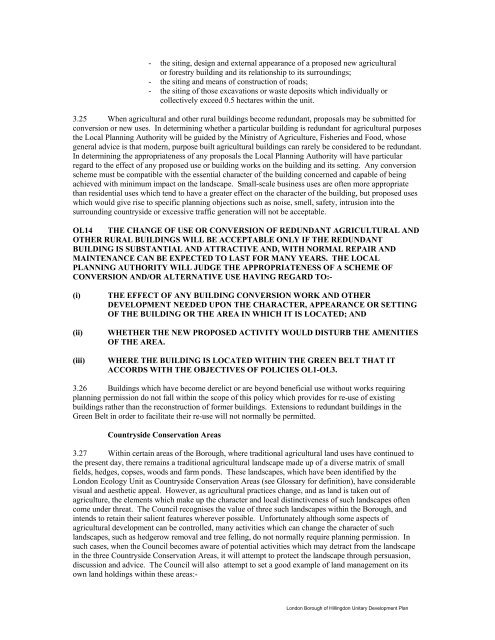HILLINGDON UNITARY DEVELOPMENT PLAN - London Borough ...
HILLINGDON UNITARY DEVELOPMENT PLAN - London Borough ...
HILLINGDON UNITARY DEVELOPMENT PLAN - London Borough ...
You also want an ePaper? Increase the reach of your titles
YUMPU automatically turns print PDFs into web optimized ePapers that Google loves.
- the siting, design and external appearance of a proposed new agricultural<br />
or forestry building and its relationship to its surroundings;<br />
- the siting and means of construction of roads;<br />
- the siting of those excavations or waste deposits which individually or<br />
collectively exceed 0.5 hectares within the unit.<br />
3.25 When agricultural and other rural buildings become redundant, proposals may be submitted for<br />
conversion or new uses. In determining whether a particular building is redundant for agricultural purposes<br />
the Local Planning Authority will be guided by the Ministry of Agriculture, Fisheries and Food, whose<br />
general advice is that modern, purpose built agricultural buildings can rarely be considered to be redundant.<br />
In determining the appropriateness of any proposals the Local Planning Authority will have particular<br />
regard to the effect of any proposed use or building works on the building and its setting. Any conversion<br />
scheme must be compatible with the essential character of the building concerned and capable of being<br />
achieved with minimum impact on the landscape. Small-scale business uses are often more appropriate<br />
than residential uses which tend to have a greater effect on the character of the building, but proposed uses<br />
which would give rise to specific planning objections such as noise, smell, safety, intrusion into the<br />
surrounding countryside or excessive traffic generation will not be acceptable.<br />
OL14 THE CHANGE OF USE OR CONVERSION OF REDUNDANT AGRICULTURAL AND<br />
OTHER RURAL BUILDINGS WILL BE ACCEPTABLE ONLY IF THE REDUNDANT<br />
BUILDING IS SUBSTANTIAL AND ATTRACTIVE AND, WITH NORMAL REPAIR AND<br />
MAINTENANCE CAN BE EXPECTED TO LAST FOR MANY YEARS. THE LOCAL<br />
<strong>PLAN</strong>NING AUTHORITY WILL JUDGE THE APPROPRIATENESS OF A SCHEME OF<br />
CONVERSION AND/OR ALTERNATIVE USE HAVING REGARD TO:-<br />
(i)<br />
(ii)<br />
(iii)<br />
THE EFFECT OF ANY BUILDING CONVERSION WORK AND OTHER<br />
<strong>DEVELOPMENT</strong> NEEDED UPON THE CHARACTER, APPEARANCE OR SETTING<br />
OF THE BUILDING OR THE AREA IN WHICH IT IS LOCATED; AND<br />
WHETHER THE NEW PROPOSED ACTIVITY WOULD DISTURB THE AMENITIES<br />
OF THE AREA.<br />
WHERE THE BUILDING IS LOCATED WITHIN THE GREEN BELT THAT IT<br />
ACCORDS WITH THE OBJECTIVES OF POLICIES OL1-OL3.<br />
3.26 Buildings which have become derelict or are beyond beneficial use without works requiring<br />
planning permission do not fall within the scope of this policy which provides for re-use of existing<br />
buildings rather than the reconstruction of former buildings. Extensions to redundant buildings in the<br />
Green Belt in order to facilitate their re-use will not normally be permitted.<br />
Countryside Conservation Areas<br />
3.27 Within certain areas of the <strong>Borough</strong>, where traditional agricultural land uses have continued to<br />
the present day, there remains a traditional agricultural landscape made up of a diverse matrix of small<br />
fields, hedges, copses, woods and farm ponds. These landscapes, which have been identified by the<br />
<strong>London</strong> Ecology Unit as Countryside Conservation Areas (see Glossary for definition), have considerable<br />
visual and aesthetic appeal. However, as agricultural practices change, and as land is taken out of<br />
agriculture, the elements which make up the character and local distinctiveness of such landscapes often<br />
come under threat. The Council recognises the value of three such landscapes within the <strong>Borough</strong>, and<br />
intends to retain their salient features wherever possible. Unfortunately although some aspects of<br />
agricultural development can be controlled, many activities which can change the character of such<br />
landscapes, such as hedgerow removal and tree felling, do not normally require planning permission. In<br />
such cases, when the Council becomes aware of potential activities which may detract from the landscape<br />
in the three Countryside Conservation Areas, it will attempt to protect the landscape through persuasion,<br />
discussion and advice. The Council will also attempt to set a good example of land management on its<br />
own land holdings within these areas:-<br />
<strong>London</strong> <strong>Borough</strong> of Hillingdon Unitary Development Plan
















